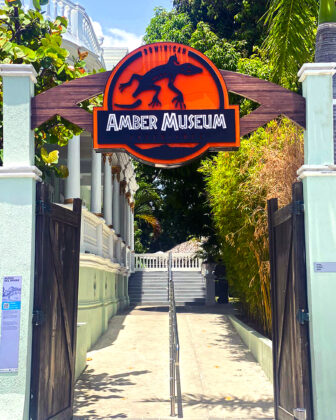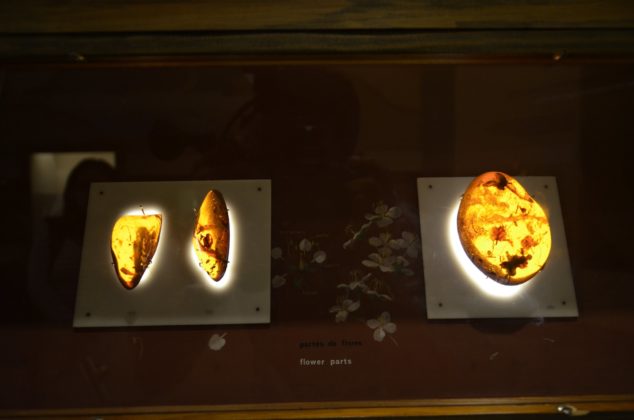The Puerto Plata Amber Museum can be considered a time capsule, a window to our prehistoric past, for the past 40 million years.
 Dominican Amber is considered among the most valuable in the world. This semi-precious gem formed during the Tertiary and Mesozoic periods, 25-40 millions of years ago. Ancient Conifer trees produced a sap that oozed out of its branches, in many cases trapping leaves, birds, insects and small animals like geckos.
Dominican Amber is considered among the most valuable in the world. This semi-precious gem formed during the Tertiary and Mesozoic periods, 25-40 millions of years ago. Ancient Conifer trees produced a sap that oozed out of its branches, in many cases trapping leaves, birds, insects and small animals like geckos.
Once fossilized, it became a time capsule, preserving the trapped species for millions of years. This sticky resin hardened into a warm golden gem later to be known as amber. It has been appreciated for its color and natural beauty since the Neolithic times. There are five classes of amber, and when it contains animal or plants inside, it is called inclusions.
Puerto Plata Amber Museum

The Amber museum has several display rooms, with an impressive collection of pieces of many sizes, containing plants, insects and other fossilized small animals ( a highlight is a 20 million year old gecko, completely preserved ).
The tour guide explains the history of amber in about 4 minutes and guides visitors through the museum exhibits, in various languages ( we witnessed him speak French, English, German and Spanish ).
The first floor of the building has a store with gift shop where amber jewelry is on display for sale, and other Dominican handcrafts. The vendors are not pushy, always smiling and used to people visiting to admire the building and the museum exhibits.
The word amber has its roots in the Arabic, Anbar. It has been discussed as early as the 4th Century BC. For amber to become fossilized, the initial resin must be resistant to decay; amber that was quickly covered with mud and vegetation was protected from the sun and elements including fungi and bacteria. Some believe the Dominican Republic amber came from the Hymenaea Protera, a prehistoric tree from the Leguminoseae family.
Jurassic Park: Dominican amber became world famous in the mainstream when the film Jurassic Park (1993) opened in theaters, with an initial scene of amber mining in the Dominican Republic; they found a mosquito from which a dna sample was taken, and a dinosaur sequenced back to life on a lab.
The Puerto Plata Amber Museum has a display wall with newspaper and magazine clips, also a replica of the walking cane Dr. Richard Attenborough used in the movie, which has a fossilized rock with a trapped mosquito in it.
FROZEN IN TIME: a prehistoric window to our past, from around the world.
The formation of amber results from a molecular polymerization, which results from high temperatures and pressures by overlying sediment, that turns the resin into the initial stage known as Copal ( 1 million years old ). Further pressure and heat results in amber.
Paleontological Significance: amber is a unique time machine, that preserves unfossilizable parts of species and helps reconstruct ecosystems and organisms going back millions of years. Cretaceous amber has yielded the most fossilized species, and the oldest amber is from the Triassic period, some 230 million years ago.
Mining: Amber is globally distributed, mainly in rocks from the Cretaceous age or younger. Baltic amber is famous, and the leading source (90%) is the Kaliningrad Oblast from Russia. It is mined in open works and underground galleries. In the Dominican Republic it is mined through bell pitting, which poses greater risks due to collapse.
 Blue Amber: This amber exhibits a rare blue coloration. It is found in the mines along mountain ranges of Santiago, Dominican Republic. A research by Vittorio Bellani and Enrico Giulotto from the University of Pavia in Italy found out that the blueness is likely produced by Perylene. Blue amber is more valuable than the standard golden one, due to its rareness.
Blue Amber: This amber exhibits a rare blue coloration. It is found in the mines along mountain ranges of Santiago, Dominican Republic. A research by Vittorio Bellani and Enrico Giulotto from the University of Pavia in Italy found out that the blueness is likely produced by Perylene. Blue amber is more valuable than the standard golden one, due to its rareness.
Villa Bentz: One interesting aspect of the museum is the Victorian architecture and history of the mansion that houses it, originally built during the economic boom of Puerto Plata during the early 18th Century by Emil Bentz, an European immigrant from Germany who met Maria Hatchmann in Puerto Plata, fell in love and married her in 1865. They became successful merchants, had a big family with 7 children and decided to build the villa, completed in 1919 by Spanish architect Martin Gallart.
The Amber Museum
Calle Duarte #61, Puerto Plata
Phones: 809-586-2848 ( information )
809-320-2215 ( Gift shop )
ON FACEBOOK
Sources & Bibliography:
















































